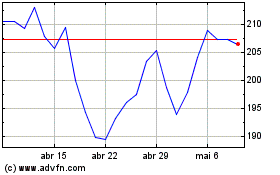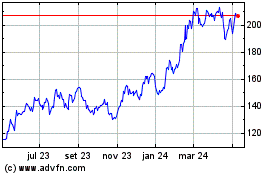U.S. Stocks May Lack Direction Following Last Week’s Pullback
18 Novembro 2024 - 11:13AM
IH Market News
The major U.S. index futures are currently pointing to a roughly
flat open on Monday, with stocks likely to show a lack of direction
following the sell-off seen last Friday.
Traders may take a step back to assess the recent volatility on
Wall Street, which saw stocks rally to record highs on the heels of
President-elect Donald Trump’s decisive victory before pulling back
sharply last week.
Concerns about the outlook for interest rates weigh on the
markets last week along with worries about the impact of Trump’s
proposed policies and cabinet nominees.
Investors may also be reluctant to make significant moves ahead
of the release of quarterly results from AI darling Nvidia
(NASDAQ:NVDA).
Nvidia, which has recently been a driver of the markets, is
scheduled to release its fiscal third quarter results after the
close of trading on Wednesday.
The economic calendar is also relatively quiet this week
compared to last week, although reports on housing starts, existing
home sales and weekly jobless claims may still attract
attention.
After coming under pressure late in Thursday’s session, stocks
showed a more substantial move to the downside during trading on
Friday. The major averages all moved sharply lower on the day,
pulling back well off Monday’s record closing highs.
The major averages climbed off their worst levels in late-day
trading but remained firmly negative. The tech-heavy Nasdaq led the
way lower, plunging 427.53 points or 2.2 percent to 18,680.12.
The S&P 500 also tumbled 78.55 points or 1.3 percent to
5,870.62, while the narrower Dow slid 305.87 points or 0.7 percent
to 43,444.99.
With the steep drop on the day, the major averages also moved
significantly lower for the week. The Nasdaq dove by 3.2 percent,
the S&P 500 tumbled by 2.1 percent and the Dow slumped by 1.2
percent.
The sell-off on Wall Street came amid concerns about the outlook
for interest rates following Federal Reserve Chair Powell’s remarks
on Thursday suggesting the central bank doesn’t need to hurry to
lower rates.
Citing the strength of the U.S. economy, Powell said the Fed can
take a careful approach to future monetary policy decisions.
The Fed is still seen as likely to lower interest rates next
month, but CME Group’s FedWatch Tool suggests the chances of a
quarter point rate cut have fallen to 58.4 percent from 72.2
percent on Thursday.
Potentially adding to concerns economic strength will lead the
Fed to hold off on future rate cuts, the Commerce Department
released a report showing retail sales increased by slightly more
than expected in October.
The Commerce Department said retail sales rose by 0.4 percent in
October after growing by an upwardly revised 0.8 percent in
September.
Economists had expected retail sales to climb by 0.3 percent
compared to the 0.4 percent increase originally reported for the
previous month.
The Labor Department also released a report showing unexpected
increases by import and export prices in the month of October,
which may have added to recent worries about sticky inflation.
“Strong retail sales, underpinned by stronger revisions,
underscores a resilient consumer but higher than expected
import/export prices puts the Fed on further alert for hotter
inflation as they assess whether a pause – rather than another rate
cut – is more appropriate at its next Fed meeting,” said Quincy
Krosby, Chief Global Strategist for LPL Financial.
Meanwhile, the Fed released a report showing industrial
production decreased in October, as the effects of recent
hurricanes and the since-resolved strike at Boeing (NYSE:BA)
continued to weigh on growth.
Biotechnology stocks moved sharply lower on news President-elect
Donald Trump has picked vaccine skeptic Robert F. Kennedy Jr. as
Health and Human Services Secretary.
Reflecting the weakness in the sector, the NYSE Arca
Biotechnology Index plunged by 3.4 percent to a three-month closing
low.
Substantial weakness was also visible among semiconductor
stocks, as reflected by the 2.4 percent slump by the Philadelphia
Semiconductor Index. The index tumbled to its lowest closing level
in over two months.
Semiconductor equipment maker Applied Materials (NASDAQ:AMAT)
led the sector lower after reporting better than expected fiscal
fourth quarter results but providing disappointing revenue guidance
for the current quarter.
Pharmaceutical, networking, software and retail stocks also saw
considerable weakness, while utilities stocks were among the few
groups to buck the downtrend.
Applied Materials (NASDAQ:AMAT)
Gráfico Histórico do Ativo
De Out 2024 até Nov 2024

Applied Materials (NASDAQ:AMAT)
Gráfico Histórico do Ativo
De Nov 2023 até Nov 2024
